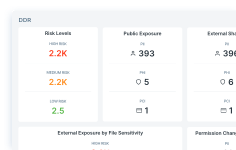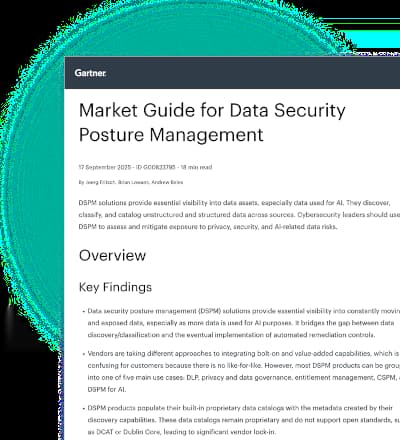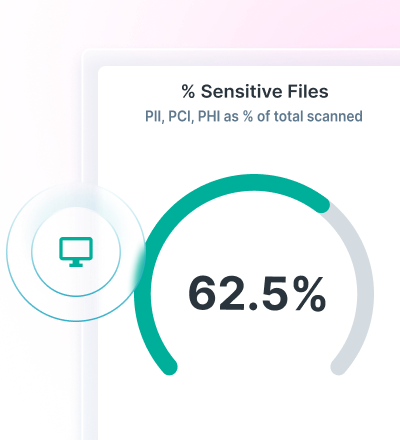Rethinking Web Security: How Next-Gen SWG Goes Beyond Legacy Filtering
0 min read

Modern work and modern risk live in the cloud. Apps, data and users now sit outside the four walls of the office, and traditional web proxies weren’t built for that reality.
Legacy secure web gateways (SWGs) struggle to see into apps, can’t reliably inspect encrypted flows at scale and frequently lack integrated data loss prevention (DLP). The result is blind spots, inconsistent controls and gaps that attackers and accidental insiders can exploit.
This guide explains what a next-gen SWG really is and which capabilities matter most.
What is a Next-Generation Secure Web Gateway?
A next-generation secure web gateway is a cloud-native security control that protects users and data across both web and cloud application traffic, wherever people work.
Unlike legacy web proxies that focus mainly on URL filtering and basic malware scanning for traditional websites, a next gen SWG:
- Sees and controls web and SaaS traffic (including shadow IT and personal app instances).
- Decrypts and inspects encrypted traffic at scale.
- Applies granular, context-aware policies based on user, device, location, app, activity and data sensitivity.
- Integrates DLP and CASB capabilities to stop data theft and misuse across browsers, web forms and cloud apps.
In short, a next-gen SWG is about complete visibility, control and data-first protection across the web and the cloud.
Why Organizations Need a Next-Gen SWG Now
Traffic has changed. Web-related activity is often through SaaS applications, and securing data on the web can be difficult without the right SWG solution. This shift overwhelms appliance-centric designs. Below are more reasons why organization need a next-gen SWG now.
- Backhauling kills experience: Hair-pinning remote traffic through data centers adds latency and cost.
- Legacy proxies miss context: They often can’t decode app activities, differentiate corporate vs. personal instances or inspect modern protocols end-to-end.
- Data risk explodes: Without DLP integrated into the same inspection point, sensitive information can move freely via uploads, pastes and third-party connectors.
- Threats are evasive: Phishing, malware delivery and command-and-control increasingly hide inside encrypted sessions and trusted cloud services.
A next-gen SWG addresses these realities with cloud-scale inspection, inline data controls and context-aware policy that travels with the user.
Core Capabilities to Look for in a Next-Gen SWG
Below is an overview of examples of capabilities that next gen SWGs might have. Also, note that capabilities may vary by vendor.
Full Web/SaaS Visibility and Control
A next gen SWG should illuminate everything users do across the web, sanctioned SaaS, shadow IT and personal instances.
Capabilities to look for in next gen SWGs:
- Discovery of managed and unmanaged apps, with risk scoring.
- Deep decoding of app activities (e.g., view, download, upload, share, post).
- Instance awareness (corporate vs. personal).
- Policy scopes by user, group, device posture, location, app, instance and activity.
Advanced Threat Protection and Malware Defense
Encrypted traffic is standard. Threats hide in trusted apps. You need advanced prevention that doesn’t trade security for speed.
Capabilities to look for in next gen SWGs:
- High-performance TLS decryption with selective, privacy-aware policies.
- Multi-engine anti-malware, sandboxing and ML-based anomaly detection.
- Inline phishing and brand-impersonation defenses.
- Early-stage detection that blocks patient-zero infections.
Integrated DLP and Sensitive-Data Controls
Traditional SWGs often treat data as an afterthought. Next gen SWGs make data the policy driver.
Capabilities to look for in next gen SWGs:
- Unified DLP across web, SaaS, email and endpoints.
- Pre-built and customizable identifiers, classifiers and templates for regulations and industry formats.
- Accurate detection in web forms, file uploads, copy/paste and APIs.
- Granular actions: block, quarantine, encrypt, coach, watermark or justify.
Application Control and URL Filtering
URL filtering still matters, but it’s not enough on its own. You need app-aware decisions that align with business intent.
Capabilities to look for in next gen SWGs:
- Application control and use-policy enforcement across both web and SaaS.
- Dynamic categories, safe search enforcement and time-based access where appropriate.
- Inline user coaching that guides to safer alternatives and builds good security habits.
Machine-Learning Analytics and Behavior Insights
Attackers adapt. Policies should, too. ML is essential to keep pace without constant manual tuning.
Capabilities to look for in next gen SWGs:
- Real-time threat intelligence and ML/AI that recognize malware, phishing and C2 patterns.
- User risk and behavior analytics that flag anomalies and elevate controls just in time.
- Correlated signals across web, app, device and data events.
Direct-to-Internet Architecture and Performance
Security shouldn’t slow business. The architecture should deliver inspection close to users with predictable performance.
Capabilities to look for in next gen SWGs:
- Global cloud points of presence and peering for low latency.
- Selective decryption to balance privacy and performance.
- Remote Browser Isolation (RBI) for high-risk browsing without risk on the endpoint.
- Built-in digital experience visibility to prove security isn’t degrading productivity.
Integration with SASE/SSE ecosystems
Your SWG should not be an island. It should unify with other edge services to simplify operations and improve outcomes.
Capabilities to look for in next gen SWGs:
- Tight integration with CASB, ZTNA and FWaaS in a single, data-centric platform.
- Shared identity, policy and analytics across services.
Ease of Deployment and Management
Security teams are overloaded. Your next gen SWG should reduce operational drag.
Capabilities to look for in next gen SWGs:
- Flexible deployment: cloud-delivered, on-premises or hybrid.
- Single-console management with role-based access and identity federation (SSO/MFA).
- Clear reporting and out-of-box policies that align to business risk from day one.
- APIs and integrations for SIEM/SOAR to automate workflows.
Practical Use Cases for Next-Gen SWGs
Translate features into outcomes your stakeholders care about.
Protecting Remote Workers and Branch Offices
Keep remote users productive and safe without backhauling. A next gen SWG should enforce the same granular policies wherever people connect.
Securing Shadow IT and Personal Cloud Services
Shadow IT is inevitable. What matters is visibility and governance. A next gen SWG should surface unsanctioned apps, distinguish corporate from personal instances and allow context-aware policies.
Compliance and Data Privacy
From GDPR and HIPAA to PCI DSS and regional data residency rules, auditors expect consistent controls and evidence.
A next gen SWG with integrated DLP should let you detect regulated data across web forms, uploads, and third-party connectors, apply the right action (block, encrypt, justify) and produce the reports that prove control.
Zero-Trust Enablement
Least-privilege is not only for private apps. Apply it to web and SaaS.
Performance with Security
Security that hinders productivity gets bypassed. A next gen SWG should bring inspection to the edge and provide transparent experience insights.
RBI removes risk from the endpoint when users reach unknown or uncategorized sites.
Choosing the Right Next-Gen SWG: A Buyer’s Checklist
Use this list during evaluations and POCs:
Visibility – What to look for
- Discovers sanctioned and unsanctioned apps
- Decodes app activities; sees corporate vs. personal instances
Threat prevention – What to look for
- High-performance TLS decryption
- Multi-engine anti-malware, sandboxing, ML analytics
Data protection – What to look for
- Integrated DLP with rich libraries and ML classification
- Inline controls for uploads, web forms, copy/paste, connectors
Policy and control – What to look for
- Context-aware policies by user, device, location, app, activity, data
- User coaching and risk-adaptive responses
Architecture and performance – What to look for
- Global cloud PoPs; RBI for risky browsing
- Experience monitoring and clear SLAs
SASE/SSE integration – What to look for
- Native unification with CASB, ZTNA, FWaaS
- One client/console/policy model
Deployment and operations – What to look for
- Cloud-delivered with hybrid options
- Single-console management; SSO/MFA; SIEM/SOAR integrations
Reporting and compliance – What to look for
- Out-of-box reports for regulations and audits
- Forensics-friendly logging with privacy controls
Vendor fit – What to look for
- Referenceable success in your industry
- Roadmap alignment and support model you trust
FAQs about Next-Gen SWGs
- What is the main difference between a legacy SWG and a next gen SWG?
Legacy SWGs focus on URL categorization and basic malware checks for websites. Next gen SWGs are cloud-native, decode SaaS activities, integrate DLP/CASB and apply context-aware policies across web and cloud. - Is a next gen SWG the same as CASB?
No. CASB focuses on deep controls and visibility inside SaaS apps. A next gen SWG focuses on inline inspection across web and SaaS traffic. The best solutions unify both, along with DLP. - How do I migrate from legacy proxies?
Start with selective groups or geographies, enable transparent identity integration, use mirror policies for a short validation window then cut over.
Explore Forcepoint Web Security
Forcepoint Web Security helps address many of the above described elements and challenges. See a preview of why organizations choose Forcepoint Web Security below, and explore more HERE.
- Control Sensitive Data on the Web: Identify and block potentially risky exfiltration attempts or data leaks anywhere on the web.
- Stop Web-based Threats: Forcepoint’s Advanced Classification Engine (ACE) prevents both zero-day and known ransomware attacks.
- Uncover and Monitor Shadow IT: Locate unsanctioned web and SaaS activity and safeguard emerging applications such as ChatGPT and Generative AI.
- Deliver Consistent Performance: Provide users with safe and reliable access to the internet, wherever they're located.

Tim Herr
Read more articles by Tim HerrTim serves as Brand Marketing Copywriter, executing the company's content strategy across a variety of formats and helping to communicate the benefits of Forcepoint solutions in clear, accessible language.
- Secure Web Gateway Product Page
In the Article
 Secure Web Gateway Product PageLearn More
Secure Web Gateway Product PageLearn More
X-Labs
Get insight, analysis & news straight to your inbox

To the Point
Cybersecurity
A Podcast covering latest trends and topics in the world of cybersecurity
Listen Now









